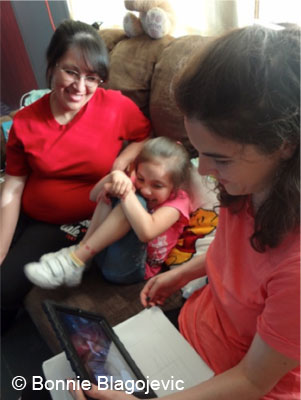Supporting Family Involvement and Readiness for Migrant Children

You are here
Ana Blagojevic, Migrant Education Program Coordinator, and Bonnie Blagojevic, Early Childhood Education Consultant, share how one program integrates technology use with traditional early learning activities so parents of young children can help their children learn at home.
Parents of preschool aged children doing migrant work in a rural Maine community wanted to better support their children’s early learning and readiness. Many families in the community were struggling to help their children prepare for school because of limited preschool options and/or a lack of quality information accessible to them about early learning topics and activities.
The Plan
Comienza en Casa | It Starts at Home, a Mano en Mano | Hand in Hand project funded by Migrant Education, integrates traditional and tablet based learning activities so parents can help their preschool aged children develop early literacy, math, science and other early learning skills. Early learning standards, resources, research, and feedback from families inform program planning.
How The Program Works
 Families participate for a three-month session. Ana facilitates monthly evening meetings at the elementary school, with help from Bonnie and Suzen Polk-Hoffses, the kindergarten teacher. They discuss learning concepts for the unit, favorite storybooks and related topics with families in Spanish. Parents also practice activities they can try at home with their child. Each family is loaned an iPad preloaded with educational apps and parent resources such as activity ideas, tipsheets, and short video clips modeling learning activities such as “sink or float” and approaches to foster exploration like “asking open-ended questions.” Activity ideas relate to the learning goals and include helping their child create stories with both the iPad and traditional materials (paper and markers), science and outdoor explorations, and educational games they can play together.
Families participate for a three-month session. Ana facilitates monthly evening meetings at the elementary school, with help from Bonnie and Suzen Polk-Hoffses, the kindergarten teacher. They discuss learning concepts for the unit, favorite storybooks and related topics with families in Spanish. Parents also practice activities they can try at home with their child. Each family is loaned an iPad preloaded with educational apps and parent resources such as activity ideas, tipsheets, and short video clips modeling learning activities such as “sink or float” and approaches to foster exploration like “asking open-ended questions.” Activity ideas relate to the learning goals and include helping their child create stories with both the iPad and traditional materials (paper and markers), science and outdoor explorations, and educational games they can play together.
During Ana’s mid-month home visits, parents talk about the learning activities they’ve done with their child and share drawings, videos, photos, and digitalstories their child created (see an example of one child’s digital story: Giving Food to a Sheep). Parents also share what their child has learned and discuss any questions they may have. Parents identify learning goals to focus on with their child in the remaining two weeks and create a video reflection to report on what took place, which they share with the home visitor at the end of each month.
How This Approached Worked
During the program parents become more informed about what their child will need to know in school and learn ways to support their child’s learning at home. One parent shared, “At first he didn’t know how to use the iPad, but now he does. He learned very quickly. It was good because he used it to read, to play, and to do other things. He’s working on the same (learning goals) but in different ways.”
Feedback from families about story reading inspired community partnerships to increase use of the town’s public library. Several families worked with the librarian to make it easier to find and borrow books in Spanish, and there are now bi-lingual story hours and additional early learning opportunities being offered at the library.
The Technology
The iPad is used as a “learning lab”, providing new access to information, a documentation tool, using the built-in camera for photo and video recording to observe and report on learning experiences, and for creative expression, using apps such as Sago Mini-Doodlecast or Book Creator to create digital stories and books.
Examples of Technology That Supports Early Learning:
Digital Story Helps Dual Language Learner Connect With Classmates
A 4-year-old boy, who speaks only Chinese, uses an iPad to write a digital story that allows him to share details about his home life with the other children in his preschool classroom.
Virtual Tour of the Titanic Helps a Kindergartner Make Social Connections
A 5-year-old child fascinated with the Titanic is given a book and interactive CD-ROM with a large screen desktop computer. The transmedia materials allow him to explore and express his interests, and develop his small motor and social skills.